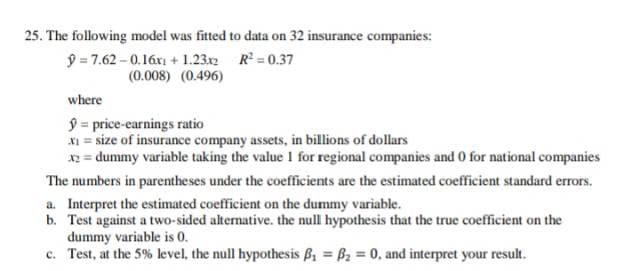25. The following model was fitted to data on 32 insurance companies: 9 = 7.62 - 0.16r + 1.23x R= 0.37 (0.008) (0.496) where ý = price-earnings ratio X = size of insurance company assets, in billions of dollars x = dummy variable taking the value 1 for regional companies and 0 for national companies The numbers in parentheses under the coefficients are the estimated coefficient standard errors. a. Interpret the estimated coefficient on the dummy variable. b. Test against a two-sided alternative. the null hypothesis that the true coefficient on the dummy variable is 0. c. Test, at the 5% level, the null hypothesis B, = B2 = 0, and interpret your result.
25. The following model was fitted to data on 32 insurance companies: 9 = 7.62 - 0.16r + 1.23x R= 0.37 (0.008) (0.496) where ý = price-earnings ratio X = size of insurance company assets, in billions of dollars x = dummy variable taking the value 1 for regional companies and 0 for national companies The numbers in parentheses under the coefficients are the estimated coefficient standard errors. a. Interpret the estimated coefficient on the dummy variable. b. Test against a two-sided alternative. the null hypothesis that the true coefficient on the dummy variable is 0. c. Test, at the 5% level, the null hypothesis B, = B2 = 0, and interpret your result.
Linear Algebra: A Modern Introduction
4th Edition
ISBN:9781285463247
Author:David Poole
Publisher:David Poole
Chapter2: Systems Of Linear Equations
Section2.4: Applications
Problem 2EQ: 2. Suppose that in Example 2.27, 400 units of food A, 500 units of B, and 600 units of C are placed...
Related questions
Question

Transcribed Image Text:25. The following model was fitted to data on 32 insurance companies:
9 = 7.62 - 0.16xi + 1.23x2 R = 0.37
(0.008) (0.496)
where
9 = price-earnings ratio
XI = size of insurance company assets, in billions of dollars
x2 = dummy variable taking the value I for regional companies and 0 for national companies
The numbers in parentheses under the coefficients are the estimated coefficient standard errors.
a. Interpret the estimated coefficient on the dummy variable.
b. Test against a two-sided alternative. the null hypothesis that the true coefficient on the
dummy variable is 0.
c. Test, at the 5% level, the null hypothesis B, = B2 = 0, and interpret your result.
Expert Solution
This question has been solved!
Explore an expertly crafted, step-by-step solution for a thorough understanding of key concepts.
This is a popular solution!
Trending now
This is a popular solution!
Step by step
Solved in 4 steps with 5 images

Recommended textbooks for you

Linear Algebra: A Modern Introduction
Algebra
ISBN:
9781285463247
Author:
David Poole
Publisher:
Cengage Learning

Linear Algebra: A Modern Introduction
Algebra
ISBN:
9781285463247
Author:
David Poole
Publisher:
Cengage Learning